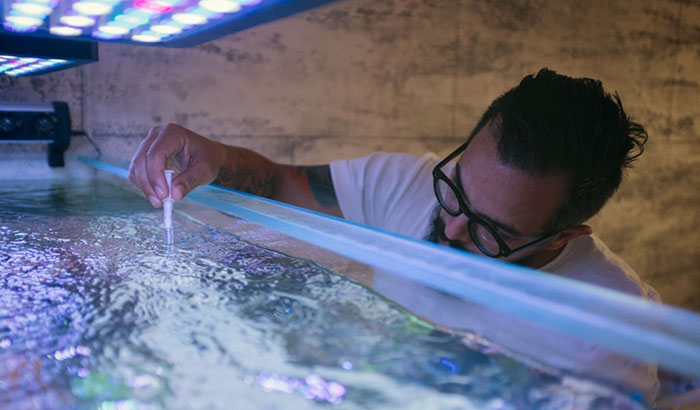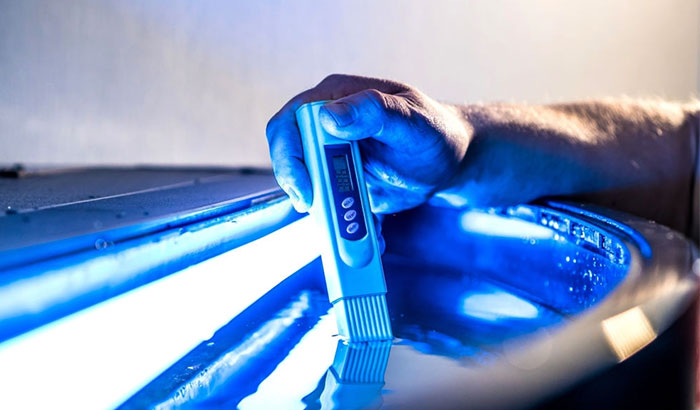Water hardness in an aquarium is due to the concentration of mineral deposits in the water. This is due to the biological process done by the pet fishes and plants to keep themselves alive. As living organisms, they both consume and release chemicals, which are then released in the water, their natural habitat. These chemicals and compounds accumulate eventually in the water.
Water hardness is known as general hardness. General hardness is measured by measuring the concentration of calcium and magnesium in water. Water with a high concentration of two minerals is of high GH, while those with low concentration have low GH. Fish in aquariums need minerals, but high levels of them may have adverse effects on your fish.
Another standard in measuring water hardness is KH that measures calcium bicarbonate levels. In general, when talking about water hardness, we refer to GH and KH. It is important to measure the water hardness of your aquarium and adjust the GH and KH accordingly. If it is too high, water hardness must be reduced. Here are the steps as to how to reduce water hardness in aquariums.
Contents
Things to Consider to Reduce Water Hardness in Aquariums
Know the appropriate GH/KH level
You must first know what is the appropriate GH/KH level for your fish. Some fish require a higher or lower level of water hardness in the aquarium. Water hardness in aquariums also depends on its size, the number of fish, and other organisms in the aquarium. Once these are taken into consideration. You can now adjust it or reduce water hardness in aquariums.
Measure the water hardness
There available materials for measuring water hardness in aquariums. Liquid test kits measure the exact levels of GH in the aquarium. You put a solution in the tube, then watch as its color changes. Match the color in the tube to that in the card to know the level of water hardness. There are separate test kits for GH and KH.
You can also use test strips. Test strips are like litmus paper, the color of the paper will change as you drop water in it. It is easier to use but gives you only general indications as to whether the water has a high or low GH/KH. Then you can decide to reduce water hardness in the aquarium, and depending on the results of measurement, by how much.
Methods to Reduce Water Hardness in Aquariums
Do reverse osmosis
One step to reduce water hardness in aquariums is reverse osmosis. It is a process where minerals are removed from the water. There is reverse osmosis system that you can install in your tap water to make it a soft one. Water run through reverse osmosis contains no mineral, pour it in the aquarium to dilute hard water of minerals and reduce the water hardness.
Use distilled water
Distilled water is very much unlike tap water. They are processed in a way that they contain almost no minerals. Distilled water can never be used as water for aquariums, fish and plants need minerals. It can be used however to dilute aquarium water to bring down the level of water hardness.
Use rainwater
Using rainwater is one of the cheapest ways to reduce water hardness in aquariums. You do not need any equipment, except a bucket. Rain contains almost no mineral, being just steam evaporating and then falling to the ground as water. Air quality though must be taken into consideration to ensure that the rain water is truly soft.
Just like distilled water, it can never be used as aquarium water on its own. It can be mixed with tap water or “remineralized” water (water infused with minerals) to bring the water hardness to the appropriate or desired levels.
Use peat moss
You can use peat moss to reduce the water hardness in aquariums. Put the peat into the aquarium filter and let the water pass through. The peat will dilute the water as it passes through, and will drain the water of minerals and other elements.
Using peat, however, to reduce water hardness in aquariums may not be that effective if the GH level is very high. It is because usually, high GH means high KH, which prevents the acidic properties of peat from working effectively to block calcium and magnesium. Using peat also makes the water brown, and thus quite unappealing.
Use Driftwood
Using driftwood as a method to reduce the water hardness in aquariums is almost the same as that of peat. One must make sure, however, that it does not contain organisms or parasites that may infect the fish and damage the ecosystem of the aquarium.
It is better to boil the driftwood to remove organisms before putting it straight into the aquarium. The possibility that organisms might survive and grow after boiling the driftwood is there, so you have to watch and observe the driftwood every once in a while.
Driftwood, just like peat, releases tannic acid, which makes the water brown. Unappealing aesthetically but completely harmless to fish. Make sure that water is constantly flowing in and out to wash away possible organisms still lurking in the driftwood. Overall, driftwood can bring the GH and KH levels without using any equipment at all.
Use appropriate items for aquariums
Factors that might also affect reducing water hardness in aquariums are the items and decorations inside the aquarium. Gravel, rocks, and some artificial plants may be shedding some minerals into the aquarium water. If after using the methods for reducing water hardness in aquariums it remains high, try removing some of the items and replace them.
Some artificial plants and stones that do not have high concentrations of minerals or do not dissolve easily are available. Stones and gravels that are free of lime can be used as a substitute for the usual gravels and rocks available for aquarium use.
Conclusion
To conclude, water hardness is important in maintaining the health of your pet fish in the aquarium. You must always take notice of it and make sure that the right level of water hardness is maintained. It is not that difficult to reduce water hardness in aquariums, and the ways and methods described above are as easy as they can be.


